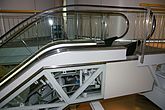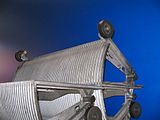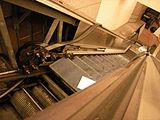Escalator
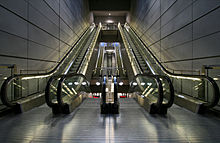

An escalator , technically known as an escalator , is a means of conveying people to overcome a height distance in which moving metal or (formerly) wooden segments form stairs. The purpose is generally to transport people at a faster speed than walking pace and / or with less muscle strength . Accelerated "transport" of people from / to a location can save time and space (e.g. on platforms).
A moving walkway is used when the metal elements do not form a staircase but a flat surface that can also be inclined and curved. Escalators and moving walks must be switched off in the event of a fire or emergency.
Escalators and moving walks are standardized in European standard EN 115.
history

In 1859 a US patent was granted for an escalator with moving steps - but since the technical concept was too complicated, no installation of this type was implemented.
On March 15, 1892, Jesse W. Reno was granted the US patent for a passenger conveyor system, which, however, did not consist of wedge-shaped steps, but of a rubber bias belt with wooden panels, i.e. actually an inclined conveyor belt with fixed, flat links. This design principle without steps was followed by all further developments of the following three decades; despite the significant difference from the user's perspective , this design is also called an escalator .
The actual inventor of the escalator is George A. Wheeler , whose patent was granted around five months after by Jesse W. Reno. However, he did not make the breakthrough himself. Charles Seeberger , who failed with his own designs, bought the Wheeler patent in 1898.
In 1893 an "electricity-driven endless inclined walkway" was built into a New York train station, which was not specifically named, and which also had a movable railing and ran at a speed of 35 cm / s. The height difference covered was 6 m with a length of 16 m. It is unclear whether this passenger conveyor system was built according to the Reno patent or the Wheeler patent.
In 1895, a passenger promotion based on the Reno patent was operated as an attraction in an amusement park on Coney Island .
The economic breakthrough came with the Paris World Exhibition in 1900 . In the USA, the systems quickly established themselves in department stores and, above all, in subway stations .
The German term escalator can be traced back to 1899 at the latest, but at that time it still referred to the function as a stair replacement or the inclined arrangement similar to a flight of stairs. An "inclined elevator (so-called escalator)" - possibly the first such system in continental Europe or at least in Germany - went into operation shortly before Christmas 1898 in the Polich department store in Leipzig .
An escalator in today's standard design with moving steps was first constructed in 1920 by the Otis Elevator Company . On July 11, 1925, the Cologne department store of Leonhard Tietz AG ( Hohe Straße ) installed what was probably the first escalator of this type in Germany and the second on mainland Europe.
According to estimates by the Association of German Mechanical and Plant Engineering, there were around 35,600 escalators in Germany in 2017.
Use in everyday life
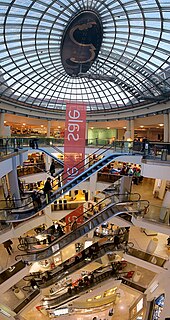
Escalators are a characteristic of urbanity , because they are usually only found in places with a lot of public traffic. Although they have a slower conveyor speed than elevators, they have the advantage that they can accommodate significantly more people. Indoor escalators tend to have slimmer flanks, often made of glass, while outdoors they are clad in metal. Due to the longer running times and the effects of the weather, escalators that are located outside and are always in operation are subject to greater stress.
The principle “stand to the right, walk to the left” has largely prevailed, provided the width of the steps allows it. The principle also applies in this form in some countries with left-hand traffic , such as the United Kingdom ; other countries with left-hand traffic, such as Singapore, invert the rule accordingly. In the house rules of the passenger stations of the Deutsche Bahn , the rule “stand on the right on escalators” is prescribed. Elsewhere, signs are sometimes used to indicate such as B. at entrances to the London Underground . So the left side should be kept free for emergencies. Unless a corresponding usage notice is already attached to the escalator, the rule “go left, stand right” is also recognized under customary law in Munich, for example. At the Basel train station, SBB regularly requests passengers to stand on the right and walk on the left in order to increase capacity. In Japan, on the other hand, this regulation is being abandoned again. Since 2015, 51 companies from the railway and elevator industry have participated in the campaign to ban people from walking on escalators. It has been statistically proven that this significantly reduces the number of accidents. It also increases the throughput of people if an escalator is fully occupied while standing.
Symbolic content
The silent film Battleship Potemkin ( Russian original title Броненосец Потёмкин Bronenossez Potjomkin ) by director Sergei Eisenstein shows a static staircase as a powerful image for the first time. In some films, the camera position and the direction of travel of the escalator are used as stylistic means.
In the 1922 silent film The All-Electric House with Buster Keaton , an escalator built into a private house with a self-adjustable speed serves as a symbol of modernity.
In the film Fight Club , the first, “accidental” encounter between the multiple protagonist and his alter ego takes place on moving walks in opposite directions.
Power consumption
A normal escalator requires an average of 2-5 kW of electrical power. The need depends on the speed and length of the stairs. The power consumption increases only slightly through exposure to people. To avoid idle times, more modern systems have sensors in the form of step plates or light barriers with a time switch logic. If the sensors have not been triggered for some time and there are probably no more people on the escalator, the electronics switch them off and only restart when someone triggers the sensor. Newer escalators are often no longer switched off completely, but continue to operate at a greatly reduced speed. Power consumption and wear are reduced less than when it is switched off, but this means that approaching passengers can be signaled that they are ready for operation and the direction of travel, and the stairs are also prevented from freezing in freezing temperatures and wet.
Escalators often have a status display with two small lights at the ends next to the handrails. Mostly green stands for in operation , rarely also blue; red signals the opposite direction of travel or a defect. Escalators in closed buildings usually do not have such a device.
safety
At the end of the escalator ride, a comb shovels, the sloping tine bars of which engage in the grooves of the step treads without grinding , objects as well as feet tend to move away from the step elements that were last arriving flat. Originally, escalators had no grooves and passengers therefore had to consciously climb over a 1 cm high edge onto the fixed end plate, which posed the risk of stumbling or being trapped. The horizontal joint is avoided by the comb, but the webs between the staircase grooves make the step edge more jagged. If you fall on the slope of the escalator, there is an increased risk of injury from the impact on the webs protruding from the edges of the stairs. Loops of textiles, straps or shoelaces lying on the floor can also get caught on these prongs and be torn into the comb at the end of the stairs. Small gaps between the steps and between the steps and the stationary side plank are particularly dangerous for the fingers and toes of small children. The cylindrically curved front of the steps used to be rather smooth and now has low vertical webs. The gap between the steps and the side plank is now usually provided with a stationary brush. There is also a risk of rubbing, squeezing and being drawn into the handrail made of rubber-textile tape, both along the planks and where the handrail (after turning back) is drawn into the staircase. If the C-profile of the rubber, which is guided by a T-rail, has some play, the risk increases.
Injuries such as severing fingers sometimes occur. Footwear that also has a very high coefficient of friction on the sides , such as B. Wellington boots, can rub sideways and twist the foot. The planks are sometimes set at a slight angle (widening towards the top) and are usually made of brushed NiRo steel or glass so that they are very smooth so that someone who falls on the stairs does not rub too hard on the plank, but rather slides off.
If a person takes a stroller up the stairs and cannot hold the tipping stroller horizontally on 2 wheels and on one step, the stroller and people can overturn each other when falling and the risk of injury is high. Some newer escalators, for example in shopping centers (e.g. Citypark Graz), are therefore equipped with a bollard in front of the beginning of the stairs to prevent use with prams (see also below on the EU directives).
Attempting to slide down or drive while sitting on the non-slip handrail can lead to falls, as can attempting to slide down next to the handrail on a stainless steel surface. Buttons are sometimes mounted on such surfaces to keep people from sliding. High-spirited people sometimes hold onto a handrail that rises up from the outside, are pulled along and then fall from a height. Where escalators run in an X-shape touching the side or run past a floor, the acute interior angles are provided with deflectors (often made of Plexiglas) to prevent an outstretched arm from jamming.
Stopping suddenly can also lead to falls. A flywheel on the rapidly rotating drive motor should prevent this.
In 1987 wooden escalators caught fire in the great fire in King's Cross St. Pancras station on the London Underground. Today, wooden escalators have essentially been replaced.
Escalators with a speed of 0.5 m / s achieve the highest conveying capacity (70% of the theoretical maximum conveying). It decreases with increasing speed (0.65 m / s: 65%, 0.7 m / s: 60%, 0.9 m / s: 45%). In the case of escalators with capacity problems, in some places the speed is increased at the expense of safety in favor of a higher total capacity.
Regulations
The EU directive on general product safety regulates, among other things, the placing on the market of technical work equipment. These also include machines such as escalators and moving walks. For these, an EC declaration of conformity must be drawn up, as provided for in the EC Machinery Directive. A CE mark must be affixed to the escalator or moving walk.
In addition, the speeds of escalators are standardized; they are only allowed to travel at speeds of 0.5 meters per second (1.8 km / h), 0.65 meters per second (2.34 km / h) or a maximum of 0.75 meters move per second (2.7 km / h). Escalators with the lowest speed are mainly used in department stores, the two faster ones in subways and airports.
The most important monitoring and safety devices
After the Euro standard will EN115 must in some situations prevents tarnishing of the prime mover, or they stop must immediately. These include power failure, grounding or overloading of electrical circuits; In addition, an overload of the drive, an overload when the motor winding temperature rises, excessive speed or an undesired reversal of travel direction; Furthermore, a failure of the auxiliary brake, a break or an impermissible elongation, which directly affects the steps, pallets or the belt-driving components (e.g. chains); a reduction in the distance between the drive and reversing devices (e.g. by blocking the step belt); External influences, such as trapping of foreign bodies on the combs of the entry points above and below, the activation of the safety devices of the handrail inlets, a lowering of part of the steps or pallets or other damage that prevents the combs from engaging, failure of the brake system to open , a difference between the speed of the steps and the handrail, open maintenance hatches, missing steps or grates as well as exceeding the permitted braking distances.
A change to the European standard EN115 on the safety of escalators has also prohibited the transport of prams on escalators since January 1, 2010. The background to this is the risk of accidents that exist for the children in the car, especially in the event of a sudden emergency stop on the escalator.
In the entrance and exit area, step gap lighting is often installed, which makes the transitions between the steps easier to see, even at horizontal points. This prevents people from unintentionally standing on two steps at the same time, since this would represent a risk of accident if the steps were later offset.
Special escalators

In addition to the usual straight escalators, there are also spiral escalators with curved runways and escalators with a landing .
Some of the few escalators can be found in the Minato Mirai 21 building in Yokohama and in department stores in Hong Kong , Las Vegas , San Francisco , Shanghai , Mexico City, and Singapore . Because of their technical vulnerability and high acquisition costs, they have so far not been able to establish themselves and have remained a prestige object. Due to the curvature, the outer side of each step must move faster than the inner side. This is solved by larger wheels on the further outward side. Due to the different loads and the highly stressed curved guide chains, wear is high and the escalator is technically vulnerable.
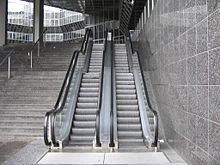
Escalators with a landing are, for example, in Barcelona Airport , in front of the Franz-Josefs-Bahnhof building in Vienna or in Tokyo subway stations (e.g. Kudanshita and others).
A special design are escalators with changing direction of travel. The direction of travel is not the same as usual and is marked with stickers, but is indicated by status displays at both ends, which indicate the current direction of travel. The change of direction of travel can be switched by the first person to step on the stairs, by time switches for peak times or other conditions that affect the flow of traffic, such as trains arriving in stations. If the change is made by the person entering, the stairs run in the direction where a light barrier is first crossed or a step sensor is pressed and quickly stops again when no one is on what is being calculated. Escalators of this type are, for example, often found on the Munich subway and the Hanover city railway , less often on the Berlin subway , e.g. B. at the Hauptbahnhof underground station and at individual exits at the Osloer Straße underground station , and should save space and money at narrow or less frequented stations compared to installing two escalators with a fixed direction of travel. With the Central Mid-Levels Escalator in Hong Kong , the change takes place depending on the time of day in order to make it easier for pedestrians to get in and out of the city center during rush hour .


The longest free-standing escalator in Germany leads to the Ruhr Museum at the Zeche Zollverein and is 58 meters long.
The longest uninterrupted escalators in the world are the four escalators of the Admiralteiskaya metro station in Saint Petersburg, each measuring 137 meters . The journey takes about 2 minutes and 50 seconds.
In the Colombian metropolis of Medellín , a 384 meter long escalator cascade, divided into six sections, was built in the poor district of Comuna 13 . The € 5.3 million facility can be used free of charge and shortens a half-hour walk over hundreds of steps to six minutes. Known escalators are z. B. in the Atomium in Brussels and in the Center Georges-Pompidou in Paris .
In the building of the hardware store built around 1995/2000 on Conrad-von-Hötzendorfstrasse in Graz , two moving walkways can be seen from the outside through the glass facade, which together form a very wide “X” in the side view, which indicates the brand that was in place until October 2015 ( Mega ) BauMaX alludes to. Trolley rollers have been developed for moving on moving walkways with shopping trolleys, which roll on a smooth floor on two radially protruding treads each, which sink into the grooves of the moving walkway plates thanks to the coordination of distance and width and thus jam sufficiently against rolling away and yet easily get off the comb ledge can be lifted out.
Escalators were also installed on aircraft carriers to move pilots from their lounges to the flight deck.
Fast and long Soviet-style metro escalators
Escalators with a particularly high running speed of up to 0.9 meters per second were manufactured in the former Soviet Union . These Leningrad- branded systems, which are often very long and steep, are intended to transport passengers to and from the platforms of Soviet metro systems as quickly as possible . Because of the typically very deep location of the stations, which can also be used as bunkers in the event of war, and the mostly missing mezzanine level, the journey on some of them takes several minutes and is therefore partly covered by the users sitting down. An escalator ride in Kiev 's Arsenalna subway station , the deepest in the world at 105.5 meters, takes almost six minutes. However, the escalator had to be divided into two parts there, which means that the passengers have to change the escalator about halfway up on a mezzanine.
As a rule, three or four escalators are arranged next to each other, conventional stairs or elevators are usually not available. Outside of rush hour there is usually only one escalator up and one down. Since the risk of accidents increases with the high speed, a supervisor at the lower end, mostly older people over 60 who cannot live on their pensions, monitors the operation in a glazed cabin. The escalator operator switches the system off in an emergency or, if necessary, depending on the volume of traffic, changes the direction of travel of the stairs. However, at least the Moscow Metro abolished its escalator supervision on April 1, 2017.
Escalators were only introduced in the Soviet Union in connection with the opening of the Moscow Metro, the first in the country. In 1933, the state- owned company Metrostroj, which was involved in metro construction, contacted the American company Otis and the German manufacturer Carl Flohr. Although the Soviet engineers were not seriously interested in buying escalators, but rather wanted technical information for a replica, they initially raised hopes for a large order from Otis and Flohr. The negotiations were artificially prolonged in order to obtain as much information as possible about the material and the functional principles. In February 1934, Metrostroj then signed contracts with two Soviet metal companies to build a total of 24 escalators. In addition, Metrostroj made further attempts to obtain the plans of western technology inexpensively - without success. But even without blueprints , the systems were finally reproduced.
Advertised as socialist products from Soviet production, the installation of the systems took place in a very limited time frame in December 1934 and January 1935. In terms of construction, the Russians had copied western technology, and in terms of dimensions they exceeded them. The escalators at the “Kirovskaja” station, now “Tschistyje Prudy”, were 60 meters long and the longest and fastest in the world. Just like the palatial, artistically designed metro stations themselves, the escalators inside also reflect the gigantism and ideological ambition of the Stalinist system of rule. They are symbols of the claim to superiority with which Soviet society under Stalin was to be shaped.
The Soviet escalators were also exported to other states of the Council for Mutual Economic Aid (Comecon), provided that metro systems based on the Soviet model were built there. An example of this is the Prague Metro . However, the Leningrad escalators do not comply with current regulations in the European Union (EU). Because the old systems cause too many accidents and use too much electricity, a single step alone weighs 40 kilograms, they can only be operated thanks to a special permit. Most of the 260 escalators in the Czech capital have already been modernized and decelerated in accordance with EU standards . In 2019, however, the city administration issued a construction freeze, the last 43 remaining "Leningrad" stairs are now to be preserved because the renovation costs are too high. At the "Anděl" station alone , one of the city's central transfer points, the exchange cost 225 million Czech crowns (8.7 million euros), with only part of the escalators being replaced there. In addition, younger users in particular criticized the new, slower stairs, which are a third slower with a travel speed of 0.6 meters per second and thus take up to half a minute longer per use.
economy
Manufacturer
Manufacturers of escalators today are, for example:
- Otis Elevator
- ThyssenKrupp
- Mitsubishi Electric (Japan)
- Schindler elevators
- Cone
- ELES , St. Petersburg , Russia ( ЭЛЕС ; in the USSR as Leningrad Mechanical Factory "IE Kotljakow" ( . Ленинградский машиностроительный завод им И.Е. Котлякова ) and production association "Eskalator" ( Производственное Объединение (ПО) "Эскалатор" ))
- Geyssel Escalator Service, Cologne , Germany
- Kleemann Group , Kilkis , Greece
Former manufacturers:
- Orenstein & Koppel
- Rheinstahl Eggers Kehrhahn
- Josef Rathgeber wagon factory
Elevator and Escalator Cartel
The so-called elevator and escalator cartel, also known as the “elevator cartel” or “elevator and escalator cartel”, set prices between 1995 and 2004, divided markets, manipulated bids for procurement orders and exchanged confidential information that was important for business. The first indications of the cartel came at the end of 2003; as a result, the investigators of the EU competition commission moved out to raids in January 2004. After more than three years of investigations, in February 2007 it imposed the highest EU antitrust fine to date with a total volume of EUR 992.3 million.
gallery
literature
- Oliver Bachmann (OTIS): Elevators and Escalators: Technology, Planning, Design (= The Library of Technology. Volume 66). Verlag Moderne Industrie mi, Landsberg am Lech 1992, ISBN 3-478-93081-2 .
- Andrea Mihm: The escalator. Cultural studies studies on a mechanically opened space. Marburg 2005, DNB 982869541 , doi: 10.17192 / z2007.0061 (online dissertation University of Marburg 2006, 354 sheets with illustrations and graphic representations, full text, PDF; 12.6 MB).
- Robinson and Kapoor: Fatigue in railway infrastructure. Woodhead Publishing, Cambridge 2009, ISBN 978-1-85573-740-2 , chap. 4 (English).
- Dieter Unger: Elevators and Escalators. A user manual. 2nd, completely revised edition. Springer Vieweg, Berlin / Heidelberg 2015, ISBN 978-3-662-46501-1 .
Web links
- elevatormuseum.com
- theelevatormuseum.org (English)
- Elevator and escalator industry in Germany. Industry report 2015. In: imu-institut.de. Archived from the original on April 2, 2015 (IMU industry study).
- Germany's tallest free-standing escalators put into operation. In: bauzentrale.com. Alfons Oebbeke, August 29, 2006(press release 2006/1486).
- Videos on the production and assembly of escalators at ThyssenKrupp Fahrtreppen
- Escalators. The human factor: user behavior, accidents and construction. In: lift-report.de. Archived from the original on July 2, 2015 .
Individual evidence
- ^ Journal for building tradesmen. Volume 37, 1893, No. 11, June 1, 1893, p. 87.
- ↑ German construction newspaper . Volume 33, 1899, No. 22, March 18, 1899, p. 144.
- ^ Peter Fuchs: Chronicle of the history of the city of Cologne. Volume 2, 1991, p. 201.
- ↑ 125 years of escalators . In: Der Spiegel . ( magazin.spiegel.de [accessed on September 27, 2017]).
- ↑ House rules of the Deutsche Bahn (as of 01/2015; PDF; 25 kB).
- ↑ Questions from city life. Why go left on the escalator, stand right. In: sueddeutsche.de. July 13, 2009, accessed August 2, 2018 .
- ^ Faculty of Social Sciences at the Ludwig Maximilians University in Munich: Go left, stand right! A field experiment to enforce informal norms on escalators. In: socziologie.uni-muenchen.de. Archived from the original on July 19, 2013 ; accessed on August 2, 2018 (article appears in: Zeitschrift für Soziologie ).
- ↑ Marc Walther: Basel residents have to learn to use escalators again. In: Basler Zeitung . September 30, 2016, accessed August 2, 2018.
- ↑ Barbara Jandl: After a fall. U1-Passgier with jacket “caught” in escalator. In: heute.at. December 17, 2013, archived from the original on December 19, 2013 ; accessed on August 2, 2018 .
- ↑ Toddler: fingers torn off escalator , orf.at, November 8, 2015, accessed November 9, 2015.
- ^ Escalator separates Bub Finger , Süddeutsche Zeitung of July 22, 2008
- ↑ Helmut Graf: Fall from the escalator. Subway accident: 19-year-old died in the hospital. In: heute.at. April 6, 2014, archived from the original on April 9, 2014 ; accessed on August 2, 2018 .
- ↑ Youtube: Before the eyes of buyers. Toddler (2) almost falls to his death from an escalator. In: heute.at. May 25, 2015, archived from the original on May 28, 2015 ; accessed on August 2, 2018 .
- ↑ Hans-Günter Schwarz: OTIS planning manual. (PDF; 210 kB) In: otis.com. OTIS , July 4, 2007, p. 217 , archived from the original on September 3, 2017 ; accessed on August 2, 2018 .
- ↑ Florian Kobler: Escalators go at maximum speed. In: ORF. March 29, 2016 ("Wiener Linien operate their escalators at a maximum speed of 0.65 meters per second. They are faster than other companies. This means that Wiener Linien has a better transport capacity, but also one accident per day." ).
- ↑ Elevator instead of escalator. In: bvg.de. BVG , January 5, 2010, archived from the original on February 11, 2010 ; accessed on August 2, 2018 (press release).
- ↑ Brochure about optional equipment. (PDF; 1.2 MB) In: schindler.com. May 11, 2009, p. 11 , archived from the original on October 20, 2014 ; accessed on August 2, 2018 (English, 03/2009 edition): "Step Gap Lighting"
- ↑ High up instead of underground. Germany’s largest free-standing escalator rolls into Essen. In: wdr.de. August 19, 2006, archived from the original on May 1, 2007 ; accessed on August 2, 2018 .
- ↑ (red): Colombia: giant escalator for the poor. In: derStandard.at. December 27, 2011, archived from the original on January 11, 2012 ; accessed on August 2, 2018 .
- ↑ (ape / sf / engf): By escalator through Medellín's poor district. The inhabitants of one of the most violent quarters of the Colombian city of Medellín are getting more mobility: They can now cover the steep stretches of the hillside «Comuna 13» using escalators. The government hopes this will also help pacify the neighborhood. In: SF Tagesschau. December 27, 2011, archived from the original on January 10, 2012 ; accessed on August 2, 2018 .
- ↑ Invention of the escalator. Up the crowds! , at spiegel.de, accessed on January 29, 2020
- ↑ See also Jason Goodwin: Otis: Giving Rise to the Modern City. Ivan R. Dee, Chicago 2001.
- ↑ a b Dispute over Prague's new metro escalators , article from September 6, 2019 on mdr.de, accessed on October 12, 2019
- ↑ Kiev: The deepest metro station in the world , article from May 6, 2017 on mdr.de, accessed on October 12, 2019
- ↑ Hungry pensioners sell their last belongings , article in Wiener Zeitung of September 4, 1998, online at wienerzeitung.at, accessed on October 14, 2019
- ↑ Moscow Metro: Travel Tips and Sights , on andersreisen.net
- ↑ Metro in Moscow: The Splendor in the Shaft , on travellers-insight.com, accessed on October 12, 2019
- ↑ End for escalator supervision: Metro abolishes "Omis mit Pedale" , Moscow German newspaper of March 12, 2017, online at mdz-moskau.eu, accessed on October 14, 2019
- ↑ a b Andrea Mihm: The Escalator - Cultural Studies Studies on a Mechanically Opened Gap , Inaugural Dissertation to obtain the degree of Doctor of Philosophy in the Faculty of Social Sciences and Philosophy of the Philipps University of Marburg, pp. 139–140, online at archiv.ub.uni -marburg.de
- ^ The Prague metro is 35. Radio Prague, report of May 9, 2009, accessed on March 15, 2012.
- ↑ Christič, UK; Kireev, Ju. V .: Sozdanie ėckalatorov novogo pokolenija - racional'nyj put 'povyšenija propusknoj sposobnosti stancij metropolitenov , technical article on updating the underground escalators in Russia, accessed on April 24, 2013.
- ↑ Web site Geyssel escalator Service
- ↑ Info on the company's website
- ↑ kaz / dpa / Reuters: Unauthorized agreements. EU fines billions against the elevator cartel. In: Spiegel Online . February 21, 2007, archived from the original on February 23, 2007 ; accessed on August 2, 2018 .








